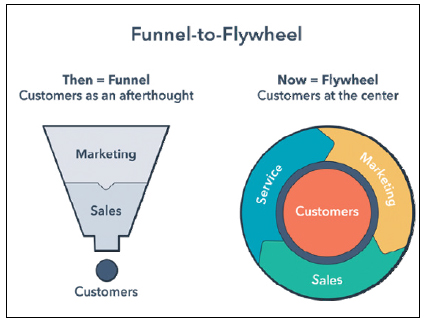 Shahid Nizami, APAC Managing Director, HubSpot [NYSE: HUBS]
Shahid Nizami, APAC Managing Director, HubSpot [NYSE: HUBS]In 1898, advertising executive Elias St. Elmo Lewis developed the concept of the marketing funnel. He conceptualized it by breaking down the buying journey into distinct stages: awareness, interest, desire, and action. Today, you can walk onto the marketing or sales floor of any modern office and chances are you’ll see a funnel, hear people talking about a funnel, or be asked to draw a funnel yourself.
Despite its 120-odd years of success, we have come to realize the funnel’s one fatal flaw – it views customers as an afterthought, and fails to recognize how delighted customers can grow a business further.
"That's why companies need to prioritize their customers and do more than just grow — they need to grow better"
According to a report by HubSpot Research, 81 percent of buyers trust their families’ and friends’ recommendations over a company’s business advice. Customer referrals and word-of-mouth have become one of the largest influences on the purchase process, meaning that marketing and sales professionals need to view customers not as an afterthought, but a driving force that is key to helping a business grow better.
Keeping customers at the core of business decision
To reflect the importance of customer obsession today, it is the concept of the flywheel that should be adopted instead. A funnel loses its momentum at its last stage (i.e. when someone becomes a customer). In contrast, flywheels leverage the momentum from customer interactions to keep spinning.
Invented by Scottish inventor James Watt, the flywheel is simply a wheel that is incredibly energy-efficient. The amount of energy it stores depends on how fast it spins, the amount of friction it encounters, and its size. These can all be translated to a business’ efforts in sales and marketing. When you think of your business as a flywheel instead of a funnel, you make very different decisions.
Unlike the funnel, the flywheel considers the business’s customers as a growth engine. Alignment across marketing, sales, and customer service is crucial in creating a positive customer experience to ensure that the flywheel keeps spinning and that a company’s customers turn into advocates.
On the other hand, when friction is present between these teams and processes, the customer experience suffers and the flywheel is prevented from spinning faster. The funnel depicts customers as an output, when in fact, they are an input, helping to grow the business through word-of-mouth.
More than just a positive spin on an old model 
Let’s start with how fast it spins. The speed of the flywheel is increased by applying more force in the areas where it can have the biggest impact. In a funnel model, all force is applied to attract and acquire customers. In a flywheel model, force is also applied to delight those customers and make them successful. When your customers are happy and successful, they recommend your business to their coworkers, friends, and family.
In most companies, different forces are being applied all around the flywheel by different teams, and leaders must ensure that no investments or projects oppose each other. A lack of alignment between sales and customer success, for instance, can create friction in the customer experience. Classic sales and marketing misalignment is another area where friction is common.
Friction can be reduced by identifying the things that cause frustration within your customer experience and making them better. Improving conversion rates, delighting customers at scale, and addressing issues that cause customers to leave are all things that increase the speed of the flywheel.
Building momentum to drive growth
Everything a business does should be done with the goal of creating customers who will add positive energy to the flywheel and accelerate growth. This is especially true now, as business operate in the face of waning consumer trust. HubSpot Research has found that when a business says it 'solves for the customer' or 'puts the customer first', only 14 percent of consumers in Asia believe it.
Similarly, 53 percent agree that businesses stop caring about them after they buy something from them. This represents a massive lost opportunity. Delighted customers turn into advocates for brands. Word of mouth is just as important as marketing, if not more so. Losing the momentum generated in creating a new customer is a drag on growth.
That's why companies need to prioritize their customers and do more than just grow — they need to grow better. Growing better means remembering that your customers are people first, not numbers on a spreadsheet — so interact with them how and when they want. It's placing customers at the centre of your business and valuing relationships, not just deals. It’s applying force to the strongest areas of your business and eliminating any friction that gets in the way — especially if it has a negative impact on your customers.
If your company views customers merely as the end product of a funnel, don’t be surprised when they start walking out of the door. But if you take the time to rethink your model to one that truly puts your customers at the center of your business (like the flywheel) you just might find yourself at the top.
Read Also